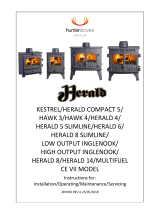BK766 Page 3
M-Series Stove User Guide
Contents
1. Identifying your stove
1.1 Identifying parts & terminology of your stove—External. ..... 5
1.2 Identifying parts & terminology of your stove—Internal ...... 6
2. Warnings
2.1 Important Warnings ............................................................. 7
2.2 Health and Safety ............................................................... 8
2.3 Smoke control areas .......................................................... 8
3. Recommended fuels
3.1 Wood ................................................................................. 9
3.2 Mineral Smokeless (Solid fuel) ............................................ 9
4. Before using your stove ........................................................... 10
5. Air inlet controls
5.1 Air inlet ............................................................................. 11
5.1.1 Primary air control location ............................................. 11
5.1.2 Primary air control ......................................................... 12
5.1.3 Secondary air control location ........................................ 12
5.1.4 Secondary air control ..................................................... 13
5.1.5 Tertiary air ...................................................................... 13
6. Lighting your stove
6.1.1 Smoke control areas ...................................................... 14
6.1.2 Fuel overloading ............................................................. 14
6.1.3 Operation with door left open ......................................... 14
6.1.4 Dampers / Air controls left open ..................................... 14
6.2 Burning wood .................................................................... 14
6.3 Warning - Fume / Smoke emissions .................................. 15
6.4 Refuelling on to a low fire bed ........................................... 15
6.5 Smoke Control Area .......................................................... 16
6.6 Typical burn for nominal output ......................................... 16
7. Further information for all stove owners
7.1 Reduced burning (Slow combustion) ................................. 17
7.2 Over firing .......................................................................... 17
7.3 Chimney fires .................................................................... 17
7.4 Periods of non-use (Summer months) ............................... 17
7.5 Ash removal ...................................................................... 18
7.6 Replacement parts ............................................................ 19
7.7 Classification ..................................................................... 19
7.8 Adverse weather conditions .............................................. 19
7.9 Door glass ......................................................................... 19
7.10 Fire door handle ............................................................. 20
8. How heat is delivered by your stove
8.1 Radiant heat ...................................................................... 21
























